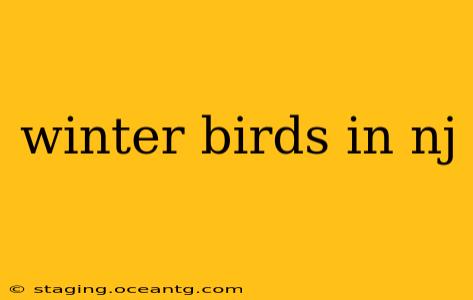New Jersey's winters, while chilly, offer incredible opportunities for birdwatching. Many species brave the cold, providing a vibrant spectacle for enthusiasts and casual observers alike. This guide delves into the common winter birds you can expect to see in NJ, their habitats, and what you can do to attract them to your backyard.
What types of birds are in NJ in winter?
New Jersey's winter bird population is a diverse mix, including permanent residents that stay year-round and winter visitors migrating from northern climates. You're likely to spot a range of species, from small, flitting chickadees to majestic raptors soaring overhead. Common winter birds in NJ include Northern Cardinals, Downy Woodpeckers, Blue Jays, Black-capped Chickadees, Tufted Titmice, and Dark-eyed Juncos. Larger birds like Northern Flickers and American Robins might also be seen, though their numbers can fluctuate. Furthermore, various waterfowl, such as ducks and geese, grace our waterways and wetlands during winter months.
What birds migrate to NJ in the winter?
While many birds migrate south from NJ in winter, some species migrate to NJ from further north. These winter visitors often seek milder conditions and abundant food sources. Specific species can vary from year to year depending on weather patterns and food availability, but you might see species like Snow Buntings, Bohemian Waxwings (irregular but spectacular when they appear), and various species of owls, like the Great Horned Owl. The Pine Siskin is another irruptive species – meaning its numbers fluctuate dramatically from year to year depending on food supplies in its breeding range.
Where can I find winter birds in NJ?
The best places to spot winter birds in NJ depend on the species you're hoping to see. For woodland species like woodpeckers and chickadees, state parks and forests offer excellent opportunities. Areas with mature trees and a mix of habitats provide diverse foraging opportunities. Wetlands and lakeside areas are ideal for observing waterfowl and other water-loving birds. Your own backyard, however, can also be a fantastic place for birdwatching, especially if you take steps to make it bird-friendly.
How do I attract winter birds to my backyard?
Attracting winter birds to your backyard is a rewarding experience, both for you and the birds. Providing food, water, and shelter are key strategies:
- Food: Offer a variety of birdseeds, suet (high-energy food), and nuts. Different feeders attract different birds. Consider using feeders that deter squirrels.
- Water: A birdbath, even a simple shallow dish, provides vital hydration, especially when natural water sources may be frozen. Keep the water fresh and unfrozen, using a heater if necessary.
- Shelter: Evergreen trees and shrubs offer protection from the elements. Planting native species provides natural food and nesting sites.
What kind of bird feeders should I use in winter?
The best bird feeder for winter depends on the birds you want to attract. Tube feeders are popular for smaller birds like finches and chickadees. Suet feeders cater to woodpeckers and nuthatches, while hopper feeders are useful for ground-feeding birds. Consider a variety of feeders to attract the widest range of species.
Are there any endangered birds in NJ during winter?
While many birds thrive in NJ during winter, some species face challenges. The state’s conservation efforts focus on preserving habitats and addressing threats like habitat loss and climate change. Keeping informed about conservation initiatives in your area and supporting organizations that protect birds and their habitats is crucial. Specific endangered species can be identified through the New Jersey Division of Fish and Wildlife.
What are the best places in NJ to go birdwatching in the winter?
Numerous locations in New Jersey excel for winter birdwatching. These locations often combine diverse habitats and offer opportunities for observing various species:
- State Parks and Forests: These protected areas frequently offer diverse habitats and attract numerous birds.
- Wildlife Refuges: These areas often include wetlands, providing ideal habitats for waterfowl and other wetland species.
- Coastal Areas: Shorebirds and waterfowl can be seen along the coastline, especially during migration periods.
By understanding the habits of NJ's winter birds and taking steps to welcome them to your backyard or while exploring nature reserves, you'll be rewarded with a unique and engaging winter wildlife experience. Remember to respect the birds' natural habitats and maintain ethical birdwatching practices. Enjoy the beauty and excitement of winter birding in New Jersey!
